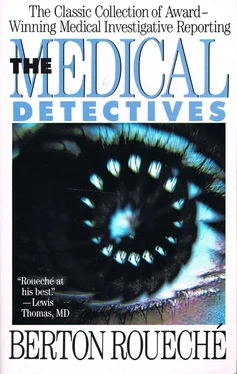It concluded, "Final Diagnosis: Hysterical neurosis, conversion type. Disposition: The patient is transferred to Granite Community Mental Health Center. The patient did not receive any medication during hospitalization nor on transfer. Prognosis: Fair."
Mrs. Terry entered the Community Mental Health Center, as a welfare patient, the same day. There is no knowing how long she might have remained there—limping, drooling, trembling, mumbling—if chance had not intervened. Its instrument was a doctor on the Center staff named David Reiser. Something about Mrs. Terry's appearance prompted him to take a second look at her file. The history of her case only quickened a suspicion he had formed. Since the Mental Health Center's diagnostic facilities were not up to proving his theory, he sent her to John Shields, an internist at a neighboring clinic that was equipped to do more elaborate tests—a liver function test, a ceruloplasmin test, a serum-copper evaluation, as well as a slit-lamp examination of the corneas of her eyes.
"I knew something important had happened," Mrs. Terry told me. "It was the way Dr. Shields and the ophthalmologist stood there looking at each other and nodding. I waited, and finally Dr. Shields turned to me. He wasn't exactly smiling, but he certainly looked pleased. He said they thought they knew what was wrong with me. He said they thought my trouble was basically not psychiatric. He said they thought I had a disease called Wilson's disease. He said he understood that it was treatable. And also, he said, it so happened that one of the leading authorities on Wilson's disease was here in Salt Lake City. His name was Dr. Cartwright, and he was the head of the Department of Medicine at the University of Utah College of Medicine. I heard what Dr. Shields was telling me. I drank in every wonderful word of it. But the thing that mattered most—the thing that put me up in seventh heaven—was that I had a real disease. I wasn't a psychiatric case. I wasn't crazy."
Wilson's disease, though something of a rarity, is only too real a disease. It is also a peculiar one. It has its origin in a genetically structured derangement of copper metabolism, and is inherited through the coincidental presence of a certain morbidly aberrant chromosome in both the mother and the father of the victim. The parents themselves, to the best of current medical knowledge, are unaffected by their possession of this baleful trait. Nor—even more baleful—is there any practical way to predetermine their carrier state.
Wilson's disease takes its name from an early-twentieth-century British neurologist named S. A. Kinnier Wilson. His classic monograph, "Progressive Lenticular Degeneration: A Familial Nervous Disease Associated with Cirrhosis of the Liver," published in 1912, is generally accepted as the first more or less comprehensive description of the disease, and it contains an impressively accurate postulation: "There is evidence to show that the disease is toxic in origin." Copper, as mid-twentieth-century nutrition importantly established, is one of the several elements essential in minute quantities to the normal functioning of the human body (it makes possible the assimilation of iron), but like some other members of this company (most notably iron), its impact in large quantities, as has long been known, can be toxic. Wilson's disease is essentially a chronic copper poisoning. In it, the natural balance between copper ingestion and copper excretion is disturbed and the copper thus retained is stored in certain organs. The liver is its first and chief repository. In time, as the storage capacity of the liver is exhausted, the continuing accumulation passes from the liver into the bloodstream and is carried to the other organs for which copper has a grim affinity. These are most conspicuously the brain and the cornea of the eye. The relentless retention of copper begins at birth, but so efficient is the liver in its protective role that years, many years—ten, twenty, even thirty years—may elapse before the first intimations of morbidity are felt.
The liver, understandably, is the first of the susceptible organs to suffer damage. This damage, however, may not immediately be clinically apparent. When it is, the manifestations are often mistaken for chronic active hepatitis. Many cases of Wilson's disease (at least forty per cent) are at this stage asymptomatic, and the first forceful indications of disease appear only when the accumulation of copper in the brain has reached a bruising concentration. These indications embrace a sweeping range of neurological disturbances—slurred speech, failing voice, excessive salivation, drooling, difficulty in swallowing, tremor (hands, head, trunk), incoordination, spasticity, muscular rigidity, progressing to bedridden helplessness. They may also mysteriously appear in the guise of functional disease, as an adolescent adjustment problem, as anxiety neurosis, as depression, even as schizophrenia. The gravitation of copper to the eye has an equally curious impact. It produces a phenomenon known to medicine (in celebration of two German investigators who were its pioneer observers) as the Kayser-Fleischer ring. A Kayser-Fleischer ring consists of a more or less complete ring of rusty-brown pigmentation—a literal implantation of copper—around the rim of the cornea. It is not known just how the copper is deposited there. The apparition, however, is at once a harmless peculiarity and a signal of the utmost clinical significance. The liver damage that occurs in Wilson's disease and its subsequent neurological disruptions may be perhaps misunderstood by the indifferent diagnostician, but only ignorance can see and ignore the Kayser-Fleischer ring. The Kayser-Fleischer rings are definitive signals of Wilson's disease, and failure to comprehend their meaning is a fateful diagnostic error. For unless Wilson's disease is opportunely recognized and promptly and appropriately treated it is invariably and agonizingly fatal.
I talked with Dr. Cartwright—Dr. George E. Cartwright—in his office at the hilltop Utah Medical Center, a big, sunny room with a view of Salt Lake City spread distantly out below. Dr. Cartwright, a graduate of the University of Wisconsin and of the Johns Hopkins University School of Medicine, is a sparkling, white-haired man in his late middle years, small and wiry, with three passionate enthusiasms—backpacking, skiing, and Wilson's disease. Indeed, as Dr. Shields was providentially aware, he is generally considered (along with Irmin Sternlieb and 1 Herbert Scheinberg, both of Albert Einstein College of Medicine, in New York, and J. M. Walshe of Cambridge University) to be among the most eminent contemporary students of the disease.
"Of course I remember Carol Terry," he told me. "Carol is one of my best successes. But it was a very near thing. Dr. Reiser caught her just in time. He had seen a case of Wilson's disease in medical school, and remembered what it looked like. I've somehow happened to see a lot of Wilson's disease—relatively a lot, I should say. We estimate the total number of cases in the United States at only around a thousand. I've seen a dozen or so. Carol was in many ways a classic case. I appreciate that Wilson's disease is not an easy disease to diagnose. Not every doctor has it prominently in mind. And I appreciate that Carol's eyes are not blue or gray or green—she has dark eyes, hazel eyes, which made her Kayser-Fleischer rings a little hard to notice at a glance. But—my lord! I remember the first time I saw her. Dr. Shields had called me and told me about Dr. Reiser's providential memory, and I arranged to have her admitted here as a research patient. I'll never forget the look of her. She looked like Wilson's disease. She had the typical masklike face and the fixed and twisted smile. She had what we call the wing-flapping tremor in her arms. Her fingers were constantly moving in what we call a pill-rolling tremor. She was drooling. I thought her Kayser-Fleischer rings were grossly visible. When I said hello to her, she answered me in that distinctive slurred speech, and in that typically squeaky voice. And then she gave that laugh they have. It's the damnedest laugh—it doesn't come in the usual way, it comes on inhalation. It was all there. She was practically a textbook presentation. I think my secretaries could have made the diagnosis.
Читать дальше












